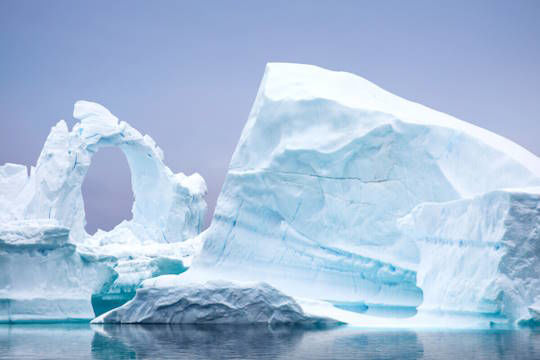(Photo: Ice in Antarctica © Lorraine Kourafas - stock.adobe.com)
The world’s mightiest ocean current is losing steam, and humans are to blame. New research shows that the Antarctic Circumpolar Current, a massive flow that helps regulate our planet’s climate, is projected to weaken by about 20% by 2050 under a high-emissions scenario due to Antarctic ice melt. The ACC was previously expected to accelerate due to increasing temperatures, but a new international study raises urgent questions about the stability of Earth’s climate system.
The Surprising Cause: Antarctic Ice Melt
What’s causing this unexpected weakening? Freshwater from melting Antarctic ice. The study, published in Environmental Research Letters, reveals that as climate change speeds up ice melt around Antarctica, massive amounts of freshwater are flowing into the Southern Ocean, throwing off the balance of salt and temperature that drives the ACC.
“The ocean is extremely complex and finely balanced. If this current ‘engine’ breaks down, there could be severe consequences, including more climate variability, with greater extremes in certain regions, and accelerated global warming due to a reduction in the ocean’s capacity to act as a carbon sink,” warns study author associate professor Bishakhdatta Gayen from the University of Melbourne, in a statement.
This finding marks an important shift in how we understand climate change effects on ocean systems. While public attention has often focused on currents in the North Atlantic, the ACC’s potential weakening could be just as significant, with far-reaching effects on climate patterns and marine life.
Why This Ocean Current Matters

Ice melting in the Antarctic Ocean could have a major impact on the ACC. (Wirestock Creators/Shutterstock)
The ACC isn’t just another ocean current. Functioning as a massive conveyor belt around Antarctica, it links the Atlantic, Pacific, and Indian Oceans, distributing heat, carbon, and nutrients throughout the world’s oceans. More than four times stronger than the Gulf Stream, it’s central to the exchange of heat, carbon dioxide, and marine life across the major ocean basins. A 20% drop in its strength under high emissions scenarios could significantly alter these patterns, affecting climate worldwide.
The current is driven by differences in water density across the Southern Ocean. Typically, the ACC has been maintained by a temperature pattern with colder, denser water near Antarctica and warmer, lighter water to the north. This creates a tilt in the ocean’s density layers, generating pressure differences that push the ACC eastward.
The Freshwater Disruption
This pattern is now being disrupted. When Antarctic ice melts, it pours freshwater into the Southern Ocean. Since freshwater is lighter than saltwater, this influx reduces the density of waters around Antarctica, weakening the north-south density gradient that powers the ACC.
“The melting ice sheets dump vast quantities of fresh water into the salty ocean. This sudden change in ocean ‘salinity’ has a series of consequences – including the weakening of the sinking of surface ocean water to the deep (called the Antarctic Bottom Water), and, based on this study, a weakening of the strong ocean jet that surrounds Antarctica,” explains Gayen.
Advanced Ocean Modeling

The slowing current could change marine migration patterns, affecting species like the emperor penguins that live in Antarctica. (Midnight In Summer/Shutterstock)
To track these changes, researchers used a sophisticated ocean model that simulates ocean processes in much finer detail than typical climate models. They ran three scenarios: a control with neutral climate conditions, a future scenario with projected wind and temperature changes but no meltwater, and another including all factors—wind, temperature, and meltwater.
When only warming and wind changes were included, the ACC stayed relatively stable. However, when meltwater was added to the simulation, the current declined significantly.
The changes aren’t uniform throughout the water. Surface waters actually show a strengthening of the ACC, driven by enhanced temperature differences. But this is overwhelmed by substantial weakening in the deeper ocean, resulting in an overall transport decline of about 20% by 2050 under high emissions.
Beyond climate impacts, the ACC serves as a natural barrier to invasive species, preventing rafts of kelp, shrimp, and other marine organisms from reaching Antarctica. As the ACC weakens, these species could more easily migrate to the Antarctic continent, potentially disrupting food webs and even affecting the diet of Antarctic penguins.
Most global climate models, including those used in international climate reports, don’t account for freshwater from melting ice shelves. They also use coarser resolution, making them too imprecise to capture the small-scale processes that affect ACC strength. Current climate projections may be missing a key mechanism that could dramatically alter Southern Ocean circulation in the coming decades.
A Path Forward Through Climate Action
While this study focused on a high-emissions scenario, researchers note that similar changes would likely occur under lower-emission scenarios if ice melting accelerates, as predicted in other studies.
“The 2015 Paris Agreement aimed to limit global warming to 1.5 degrees Celsius above pre-industrial levels. Many scientists agree that we have already reached this 1.5 degree target, and it is likely to get hotter, with flow-on impacts on Antarctic ice melting,” says Taimoor Sohail, a climate scientist from the University of Melbourne.
However, there is still hope. Sohail suggests that focused efforts to reduce carbon emissions would limit Antarctic ice melting and could help prevent the projected ACC slowdown.
A Warning from the Deep Southern Ocean
What’s clear from this research is that the pillars of our global ocean circulation system are being altered by human-caused climate change. The changes we’re imposing on our planet through greenhouse gas emissions aren’t just affecting obvious things like temperature and rainfall patterns. They’re also changing the fundamental circulation systems that have regulated Earth’s climate for thousands of years.
The Southern Ocean has long been out of sight and out of mind for most people, but changes happening there will eventually reach all of us. As the ACC weakens, heat distribution patterns will shift, marine species will migrate to new areas, and weather systems may become more unpredictable. The question isn’t whether we’ll feel these effects, but when and how severely they’ll manifest in our daily lives. The current is slowing—our response cannot afford to do the same.











